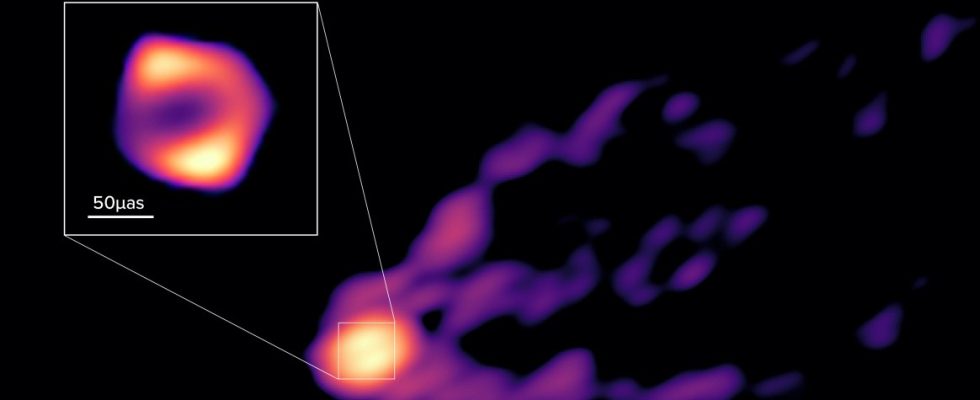Joint observations with radio telescopes around the world have allowed astronomers to look inside the engine of an active galaxy core for the first time. The radio images show not only the vortex of infalling matter around the supermassive black hole of galaxy M87, but also the emergence of a collimated jet of matter shooting out from the black hole at nearly the speed of light. After years of complicated evaluations, the international research team presents his results now in the journal Nature.
Galaxy M87 is 55 million light-years from us and hosts a black hole at its center 6.5 billion times the mass of our sun. Both of these factors – its large mass and astronomically small distance – make M87 the most important object for astronomers to study the vicinity of such massive black holes.
Almost every galaxy has a large black hole at its center that is millions or even billions times the mass of the sun. If matter falls into the black hole, it becomes “active”: It emits radiation that can shine even brighter than its entire galaxy. The infalling matter first forms a hot, rotating disk around the black hole, only from there does it whirl into the gravitational abyss. Some of the matter, however, is deflected – presumably by magnetic fields – and bundled into matter beams. These jets can reach far into space.
The evaluation of the data took five years
In order to study the exact mechanism of this process, i.e. the engine of such active galaxy nuclei, astronomers have to look at the center of a galaxy with high resolution. To do this, they use the so-called Very Long Baseline Interferometry (VLBI), in which radio telescopes around the world observe together and the data are then linked together. As early as 2017, a sensational image of the black hole in the galaxy M87 was achieved with a special VLBI network, the Event Horizon Telescope. The “shadow” of the black hole was visible there for the first time, an area from which no radiation reaches Earth.
To get an even better picture of the black hole’s surroundings in M87, the research team used a global VLBI mesh dedicated to millimeter-wave observations. However, due to the positions of its antennas, this network has better resolution in the east-west direction – antennas far north and south were missing. The researchers have therefore also integrated the ALMA antenna system in Chile and a radio telescope in Greenland into their network.
In addition, the team used AI machine learning methods for the first time to further sharpen the images by comparing them with simulated data. However, all of this also made the evaluation more complex: the observations were made in April 2018 – and only now, five years later, can the scientists – a total of 117 researchers from 64 institutes were involved – publish their results.
But the effort was worth it: the radio images not only show, like the images from 2017, a ring-shaped structure around the black hole. They also reveal for the first time that a jet of hot, electrically charged matter emanates from this ring, the beginning of a jet. “It’s the first image that shows us where the ring is relative to the energetic jet emanating from the central black hole,” explains Kazunori Akiyama of the Haystack Observatory in the US, who was instrumental in developing the evaluation software of the data was involved.
“These new results are so important because they give us, for the first time, a direct look into the region connecting the central accretion disk around the black hole and the jet in M87,” emphasizes Anton Zensus, Director at the Max Planck Institute for radio astronomy in Bonn, which was also involved in the observations. “The years of continuous expansion and further development of the VLBI technology have definitely paid off.”
Now the researchers want to further improve the VLBI method, observe at several wavelengths simultaneously and also record the polarization of the radiation from the center of M87. This made it possible to determine the temperature of the matter and the strength of the magnetic fields. This would enable further insights into the exact physical processes that take place in the engine of the galaxy’s core.

